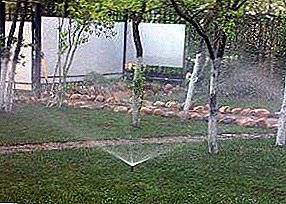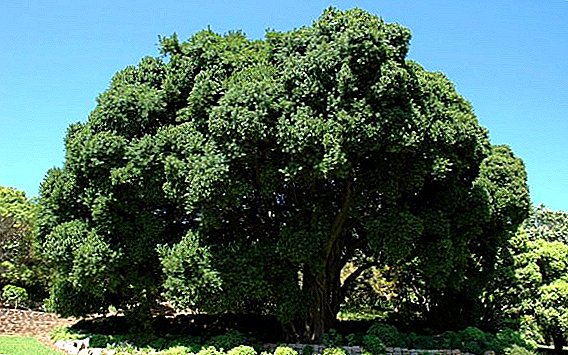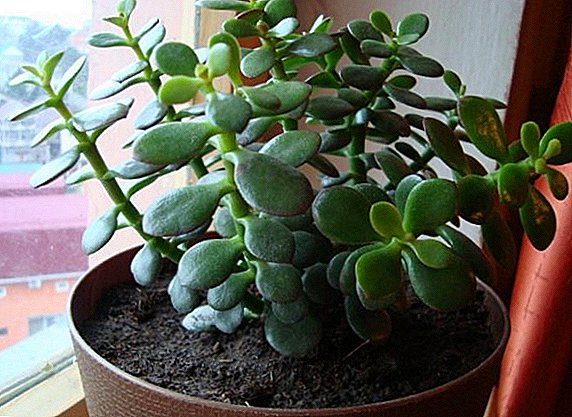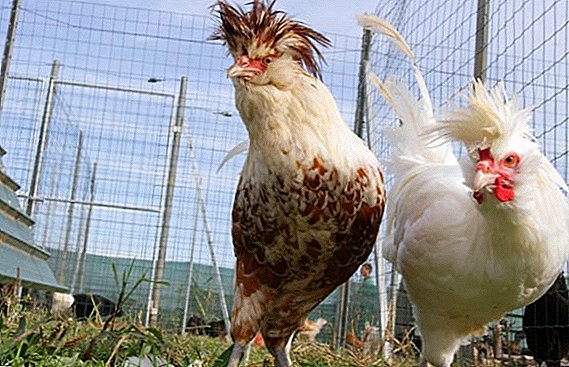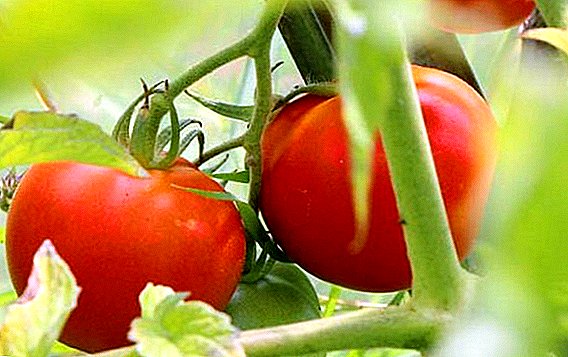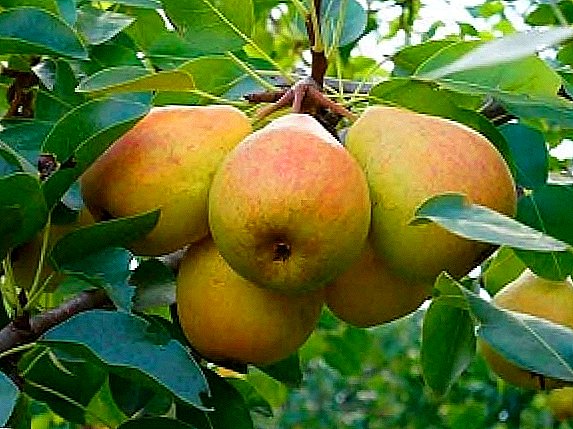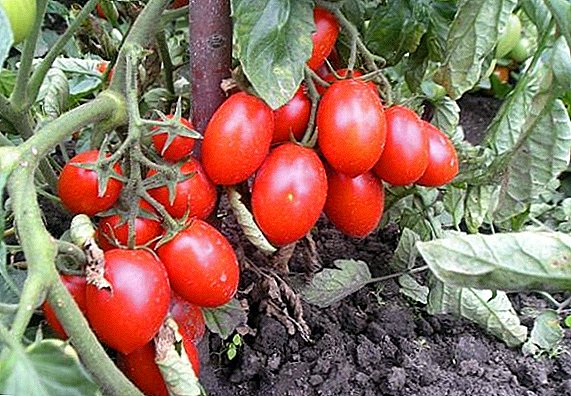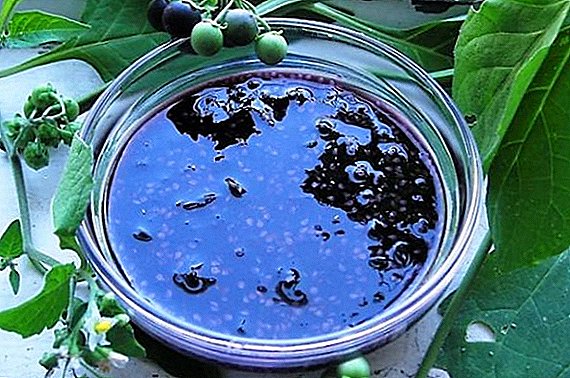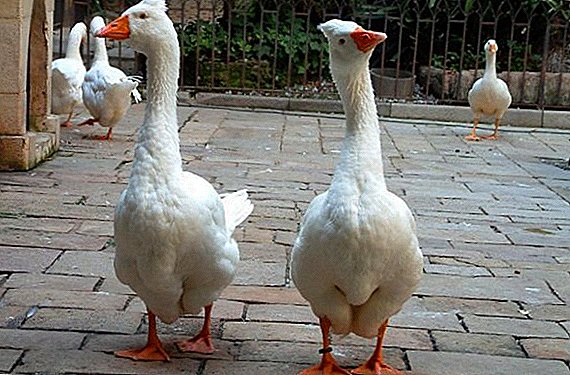 Italian geese (the exact name is Italian white) is a fairly old breed, considered the most popular and in demand not only in the historic homeland, but also in many other parts of the world, including the countries of the former CIS. They are medium-sized birds, unpretentious and versatile in the economy. What are the features of the breeding of these birds and their productive characteristics, we learn in this article.
Italian geese (the exact name is Italian white) is a fairly old breed, considered the most popular and in demand not only in the historic homeland, but also in many other parts of the world, including the countries of the former CIS. They are medium-sized birds, unpretentious and versatile in the economy. What are the features of the breeding of these birds and their productive characteristics, we learn in this article.
Breed history
 Italian white geese were bred as a separate breed in the nineteenth century. In the selection work the Italians used native birds of white color and geese brought from the Middle Kingdom.
Italian white geese were bred as a separate breed in the nineteenth century. In the selection work the Italians used native birds of white color and geese brought from the Middle Kingdom.
The addition of "Chinese blood" has significantly improved the original breeding material.
Since Italy is traditionally one of the most visited countries in Europe, the new breed was quickly brought by tourists, first to neighboring countries, and later to more remote regions.
Did you know? The Italians, as is well known, have special reasons for treating geese, because in 390 this bird saved Rome from the invasion of the Gauls. The great city was under siege for a long time, but starving people did not dare to eat the sacred geese who lived in the temple of Juno, fearing to anger the goddess. One night the enemy made a desperate attempt to seize the city. Invaders crept so silently that no dog barked. But the geese were cackling. The noise raised by them, as legend has it, woke a warrior named Mark Manlius, he detected danger in time and raised the alarm. The assault attempt was choked, and the city was saved.
Soviet citizens, not spoiled by trips to capitalist countries, got the opportunity to get acquainted with the white Italian bird much later than the Europeans. This happened in 1975, when several individuals were experimentally brought into the Union from friendly Czechoslovakia. Surprisingly, already in 1980 the bird population in the Soviet territory was about 35 thousand heads.  Since then, Italian geese have firmly established themselves on 1/6 of the land and today they are actively grown both in small plots and in large poultry farms.
Since then, Italian geese have firmly established themselves on 1/6 of the land and today they are actively grown both in small plots and in large poultry farms.
Familiarize yourself with the breeds of geese for home breeding: Kuban, gubernatorial, Chinese, Linda, Hungarian white, Toulouse, Rhine, Kholmogory.
Description and features
Imagine an ordinary snow-white goose, without any additional fads in appearance, such as frightening growths on the beak of a male, but ideally folded and literally exuding confidence and strength. This is an exact portrait of "Italian". 
Appearance and physique
Here is a more detailed description of the Italian goose:
- tail - well developed, has a horizontal fit, tight to the body;
- chest - slightly raised, rounded, well developed;
- back - well developed, slightly arched and slightly sloping towards the tail;
- belly - deep and rounded, but without fat folds;
- wings - long, set high, tight to the body;
- trunk - proportional, rounded, slightly elongated and elevated at the front;
- head - small in size, proportional, the back of the head is flat, the cheeks are well developed, in geese sometimes with a tuft;
- eyes - big, blue, with orange eyelids;
- beak - straight, short and thin, orange-colored, without a hump and a characteristic "bump" that distinguishes the male in some breeds of geese;
- neck: short, very elegant, slightly arched at the top;
- shins - long and well developed;
- metatarsus - strong and powerful, not long, of the same color with the beak, but the paws are slightly lighter;
- plumage - dense and rigid, downy layer is small;
- color - white, ideally completely homogeneous, but sometimes several gray feathers can occur, it is considered a disadvantage, but insignificant.
 Not possessing a pretentious appearance, Italian geese, nevertheless, look very attractive. Their characteristic feature is proportional physique, grace and modest grace.
Not possessing a pretentious appearance, Italian geese, nevertheless, look very attractive. Their characteristic feature is proportional physique, grace and modest grace.
Important! Too powerful or, on the contrary, weak appearance, disproportionate head, long neck, short or strongly “overpriced” body, presence of folds on the body, short legs, clumsy movements, too soft down and non-uniform color - all this is considered a marriage.
However, the same drawbacks, if they are not very pronounced and minor, are acceptable, although the value of such a bird for breeding decreases.
Character
As befits the legendary Italian geese, the birds of this breed differ activity, rapidity and independent character. Males are very attentive to the protection of their wards, not allowing the feathered family, not only natural enemies, but also their relatives of other species and breeds. Carrying out guard functions, ganders often act as instigators of conflicts and can arrange small fights. 
Hatching instinct
But the female half of the Italian goose family does not differ in this responsibility to fulfill its duties. Mummies from geese of this breed turn out, frankly, so-so. Maternal instinct and the incubation instinct is rather poorly developed in them, therefore in small households where there is no own incubator, the cuckoo eggs accounted for put other geese. For example, such breeds as the Danish legart, Arzamas, Vladimir clay, large gray, Tula fighting, Shadrinsk (Ural) breeds cope well not only with their own eggs, but also with foreign eggs.
Important! When choosing a breed for hatching eggs, preference should be given to small birds, since heavyweights often damage the shell, settling on the laying.
From this point of view, the Ural geese are a good option, they are not larger, and sometimes even a little smaller, than “Italians”. However, some farmers claim that the “Italians” themselves can successfully cope with the task, each owner has his own secrets how to make the goose sit on the eggs.
Productive characteristics
In terms of productivity, Italian white geese are an excellent choice. Their meat and liver have excellent taste, they are well gaining weight, in addition, the breed has good egg production. The soft and dense feathers of these birds, which also have a wonderful natural whiteness, are widely used in light industry, especially when sewing warm clothing. So, with each bird with regular plucking, you can get up to 100 g of fluff and up to 200 g of feather each year. 
When they start to nest and what egg production
The Italian white goose reaches sexual maturity by 8–10 months and averages on average during the year. 45 to 55 fairly large eggs (the mass of each is about 165 g) with snow-white, like bird plumage, shell.
Important! Geese, unlike chickens, do not rush constantly. During the year, as a rule, there is only one cycle of egg-laying, which is followed by incubation of eggs and care for the chicks. However, there are ways to "deceive nature" and achieve two, and in some breeds of geese, even three cycles. However, it should be borne in mind that the nestling instinct in a goose appears only in the spring, therefore, the young of the eggs from the “additional” cycles can be obtained only with the use of an incubator.
With reference to Italian whites, it is possible to achieve the second clutch in the fall, and in this case the annual egg-laying rate increases to 70-80, and sometimes to 90 eggs. The whole period of good goose egg production lasts 8-10 years, but at the maximum level 5 years are kept.
It should be noted that these parameters of egg production are quantitatively classified as medium in terms of quantity and weight of eggs, and as high in terms of the length of the period of egg production. 
Precocity and live weight
Adult geese of Italian breed weigh:
- males - from 5.5 to 8 kg;
- females - from 4.5 to 6 kg.
| Egg fertilization | 90% |
| Successful incubation results (appearance of live chicks) | 65-70%, in a good automatic incubator - up to 100% |
| Survival rate of young stock | Up to 100% |
| Weight gain goslings to the age of two months | 3 kg (females), 4 kg (males) |
| Weight gaining goslings by the age of three months | 4 kg (females), 5 kg (males) |
As a result, Italian whites belong to the few breeds that allow youngsters to score next spring. Bird reaches commodity sizes already by 9 weeks, and it is better to hammer it in before the first molt, in this case the carcass will look much more attractive (just by the absence of the characteristic stumps on the carcass appearing after the molt, you can distinguish a young goose from a mature bird).
Read also about the composition, nutritional value and culinary use of goose meat, fat, eggs.
However, rearing chicks up to 5-6 months is considered economically feasible, by this age they usually gain their final weight.  Foie gras liver In addition to delicious meat (which, by the way, due to its high density, ideal for smoking and curing), the breed is quite suitable for such a specific use as feeding fatty liver.
Foie gras liver In addition to delicious meat (which, by the way, due to its high density, ideal for smoking and curing), the breed is quite suitable for such a specific use as feeding fatty liver.
Did you know? The production of foie gras, the famous French delicacy of duck (foie gras de canard) or goose liver (fois gras d'Oie), is perhaps the most cruel treatment of animals that one can imagine. The bird is kept in a confined space, which does not allow it to move (earlier ducks and geese were nailing the floor to the ground) and force-fed through a special probe. The fabulous cost of the resulting dish has an economic explanation: the death of an animal before its liver reaches its “proper” size occurs 20 times more often than when it is grown for meat.
Those who managed to reach a compromise with their conscience should know that the forced fattening of geese of the Italian breed allows you to get a liver weighing 500-600 g, which is about 7% of body weight. For this purpose, either adult birds or young animals between the ages of three to six months are used (the live weight of the individual should not initially be less than 4.2 kg).  Fattening for fatty liver It should also be noted that for larger meat carcasses, Italian geese are often mated with heavy goose, but such broiler geese are not used in the parent herd, since they have less egg-board than the purebred “Italians”.
Fattening for fatty liver It should also be noted that for larger meat carcasses, Italian geese are often mated with heavy goose, but such broiler geese are not used in the parent herd, since they have less egg-board than the purebred “Italians”.
What to feed
Fattening on a fatty liver is a very special system, below we will speak not about it, but about the peculiarities of the diet of Italian geese grown in the usual, "humane" way.
Adult flock
For Italian geese, traditional pen and grazing systemin which the bird receives a part of its ration from the farmer, and the rest (first of all, it concerns green grass) produces independently.
Important! The share of greens in the diet of Italian geese should be 70-80%, thus, well-organized walking allows you to achieve fivefold savings in feed!
In this case, the usual four meals a day, the necessary geese, can be fully provided only by one feeding in the evening, and during the day the flock will frolic and feed on free-range.  The daily ration of geese for one individual should look like this:
The daily ration of geese for one individual should look like this:
| The name of the component | amount |
| Boiled potatoes | 150-200 g |
| root vegetables and other vegetables (for example, pumpkin) in ground form, mixed with concentrated food | 150-200 g |
| Herbal flour (hay) | 50-100 g |
| Bran | 50 g |
| Cereals (oats, barley, corn) | 50-100 g |
| Fine gravel, chalk, crushed eggshell | 5 g |
| Salt | 2 g |
| Freshly cut green grass, leaves, needles (if the bird is contained in an aviary) | 2 kg |
| Vitamin and mineral supplements (in winter) | In accordance with the instructions |
You can add to the diet of geese products of animal origin, in particular, dairy products, eggs. But sprouted potatoes are contraindicated for birds, because the glycoside of corned beef contained in such tubers is quite a strong poison. For the same reason, you can not add to the mash potato broth. And, of course, we should not forget that birds should always have unhindered access to clean water. 
Youngsters
An important mistake that beginner farmers often make is that newly hatched chicks begin to feed immediately. Do this categorically should not be!
Important! In the stomach of the chick at the time of "birth" is still a small amount of yolk, allowing the body for some time to do without food. This is the mechanism laid down by nature for the protection of young animals from starvation in the first hours of life. Additional feed during this period will be a serious load for an undeveloped digestive system, which may even lead to the death of the bird. Therefore, the first feeding should be postponed for at least 8 hours.
Feed goslings need for age, following such a scheme (the amount is indicated in grams):
| The name of the component | Nestling age | |||||
| 1-5 days | 6-9 days | 10-19 days | 20-29 days | 30-39 days | 40-60 days | |
| Corn | 15 | 20 | 40 | 96 | 97 | 100 |
| Wheat bran | 3 | 6 | 14 | 40 | 50 | 60 |
| Animal feed (dry) | 2 | 4 | 10 | 15 | 15 | 12 |
| Carrot | 5 | 20 | 20 | 20 | 0 | 0 |
| Legumes (stems and leaves) | 5 | 20 | 60 | 100 | 200 | 400 |
| Skimmed milk | 25 | 50 | 50 | 10 | 0 | 0 |
| Crushed shell | 1/3 | 1/2 | 1 | 3 | 4 | 5 |
Further, starting from 3-4 months, the amount of protein and concentrated food should be drastically reduced, because by this age the gain in muscle mass is completed, and the excess feed will go "into fat", which will significantly lower the quality of the carcass. 
Conditions of detention
Another indisputable advantage of the Italian white geese is their unpretentiousness. A properly equipped house, regular cleaning, timely vaccination for the prevention of dangerous infections - that is all that is required to provide the feathered herd.
We advise you to read about the conditions of detention and measures of care for geese and geese.
How to equip a goose
The following requirements are imposed on the gooseberry:
- Dimensions. Goose is a large and active bird, ideally should strive to ensure that each individual has at least 1 m² of area. The optimum height is 2.1 m.
- Isolation. It is necessary to avoid sharing the geese with other agricultural birds, and Italian whites - even with other goose breeds. It is not only a matter of possible conflicts, but also in different conditions that are necessary for one or another type. So, geese create high humidity in the house, because they constantly splash in drinkers, this can lead to an increase in the incidence of chickens. On the other hand, for stable egg production, chickens need artificial finishing of light, while geese need not rush ahead of time.
- Lighting. Goose will have enough natural light if there are large windows in the house (well insulated). The total area of window openings at the above height of the room should be at least 10-15% of the floor area.
- Protection from precipitation and wind (drafts), as well as predators, rodents and other vectors of infections.
- Good ventilation. Air stagnation increases the risk of fungal and other infectious diseases.
- Humidity at the level of 65-75%.
- Litter. In the house it performs two functions - hygienic (absorbs moisture, absorbs dirt) and at the same time is a heater. Therefore, the composition of the litter depends on the time of year. In the summer, sand or sawdust (preferably coniferous) is suitable for this purpose, in winter it is better to use straw (dry and clean) or peat, and they should be laid in a layer of at least 12-15 cm.


Important! If during the construction of the house the insulation for walls is used, they should be very carefully sealed from the inside at a level of 1 m from the floor, since the geese are able to reach the "suitable material" during the construction of the nests, completely stripping the entire plaster. With no less frenzy, the goose, while preparing for a hatching, plucks out its own feathers, therefore, it is necessary to watch very carefully that there is a sufficient amount of straw in the house.
Italian whites tolerate temperature changes well and, in general, can remain healthy and happy in both heat and frost. Another thing is that in order to maximize the weight gain of youngsters in the house, it is recommended to maintain the temperature at + 12 ° C to + 15 ° C, since it is in such conditions that the birds have an increased appetite and, accordingly, eat more food.
Walking and access to water
Since the breed in question is distinguished by its truly Italian character, it is not very suitable for her to be in a closed aviary. Moreover, in this case, the farmer needs to provide the feathered herd with a significant dietary supplement, which can be avoided if the geese get the opportunity free grazing. Thus, walks are necessary for Italian white for two reasons: to give an outlet with a key of energy and to have a good meal.  But without a reservoir, these waterfowl just can do well.
But without a reservoir, these waterfowl just can do well.
Did you know? Contrary to popular belief, geese spend much less time on water in the wild than swans or ducks. The pond needs this bird not for getting food, but for a completely different purpose: under the action of the buoyancy of water, the body of the goose acquires lightness, which is very useful at the time of mating. In addition, in the process of hatching eggs, the goose should moisten them with water.
But Italian geese, unlike their heavy relatives, can perfectly perform the act of love on land, and in the presence of an incubator, the question of wetting eggs disappears by itself (however, ordinary troughs filled with water are suitable for this purpose). The growth rate and egg production rates are not affected by the proximity of the reservoir.
How to endure winter cold
Italian whites tolerate frost well, so additional heating in the house is not necessary. It is only important that there are no gaps in the room, and additional heat can be obtained through proper use of the litter. So, straw and peat, thickly lined in a roaster, as far as pollution is not removed, as is the case in summer.  Clean litter is placed directly on top of the "old". After some time, decomposition processes begin in the lower layers of organic matter, accompanied by the release of heat. With good insulation, this is quite enough so that the indoor temperature does not fall below zero.
Clean litter is placed directly on top of the "old". After some time, decomposition processes begin in the lower layers of organic matter, accompanied by the release of heat. With good insulation, this is quite enough so that the indoor temperature does not fall below zero.
Learn how to determine the sex of geese; choose a goose for a tribe; slaughter and butcher the goose.
Advantages and disadvantages
To unconditional merits Italian breed should be attributed:
- high egg fertility rates, good incubation results, excellent survival of the young;
- precocity, very fast weight gain;
- the ability to easily obtain larger broilers by mating females with heavy breeds;
- good egg production;
- long-term stable egg production (five years);
- high taste of meat;
- versatility (can be grown for meat, fatty liver, for the production of eggs, as well as for getting fluff and feathers);
- unpretentiousness;
- good adaptability to different climatic conditions;
- the possibility of keeping away from the reservoir;
- grace and visual appeal.
Scroll deficiencies looks much shorter.  Among them are:
Among them are:
- poorly expressed incubation instinct;
- aggressive nature of the gander, excluding joint content with other breeds.
Poultry breeders reviews about the breed

It is safe to say that Italian whites are an excellent choice for a novice poultry farmer, regardless of whether he is going to raise geese as poultry or open his own farm. For over a hundred years this breed is rightly considered to be one of the most successful not only in its homeland, but also in many other countries, including Russia, Ukraine and Belarus.


